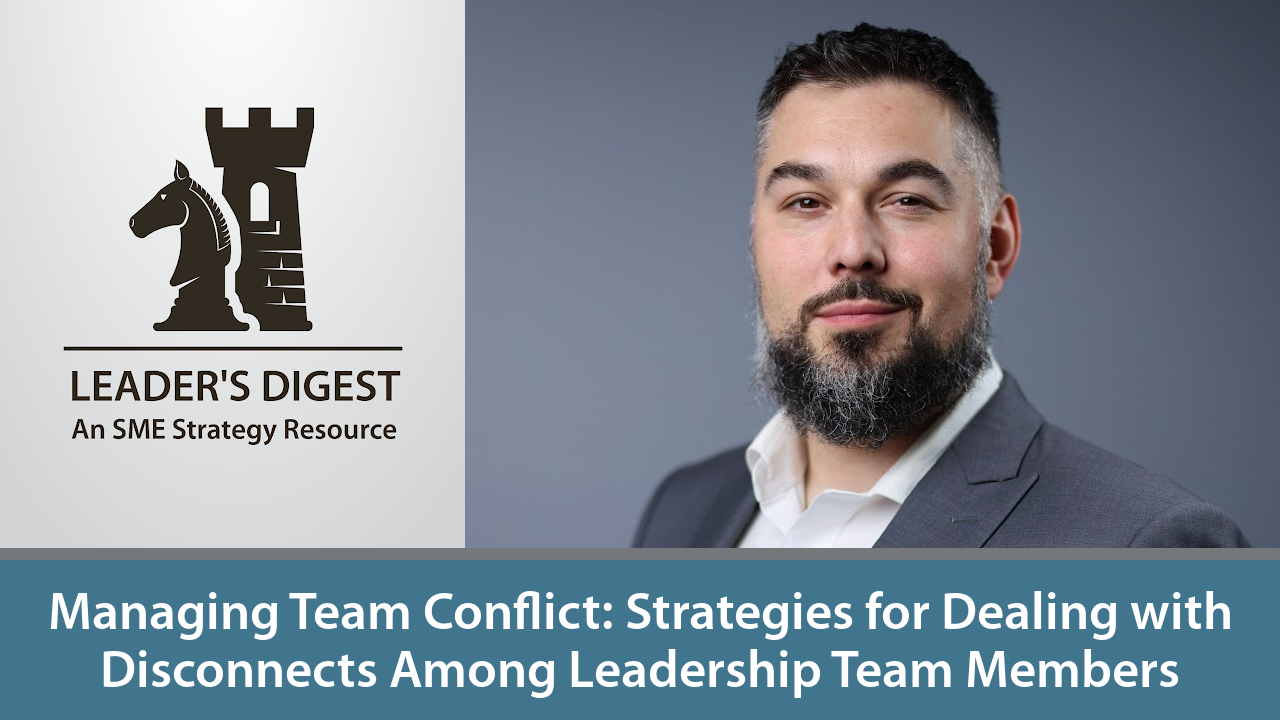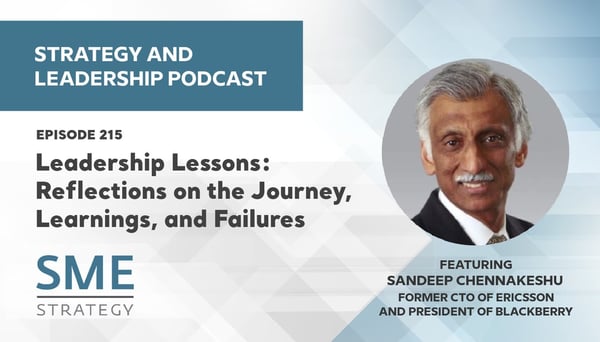Team Conflict: How to Manage a Disconnect Between Members of Your Leadership Team

SME Strategy is a strategy consulting firm that specializes in helping organizations align their teams and operations around a shared vision, mission, values, goals, and action plans. Our strategic planning services offer guidance on how a strategic planning facilitator can provide support in constructing an effective strategic plan that ensures your strategy is communicated and implemented across your entire organization.
Leader's Digest #14
Get our exclusive insights straight to your inbox! Subscribe now to Leader's Digest, our bi-weekly newsletter.
As we navigate the complexities of the business world, misunderstandings and miscommunications can often arise between members of our leadership teams. Before we can manage and resolve any conflict, we must first understand the people involved and the context of the situation.
This led me to wonder: What distinguishes a conflict from a disconnect, and how can we build stronger connections within our organizations?
In today's business culture, we often strive for a constructive environment, but all too often, we end up with a passive-aggressive one instead. This type of behavior rarely leads to successful strategy execution. According to a survey by Human Synergistics International, most leaders are not aware of the impact they have on their teams and colleagues.
Many organizations claim to support excellence and strategic implementation, but their actions may inadvertently reinforce coping and survival behaviors instead.
In reality, many organizations tend to take a more passive and defensive approach. This means that people shy away from taking the initiative and accepting responsibility, often trying to avoid being blamed for anything that goes wrong. On the other hand, you see some organizations adopt a passive-aggressive style that's characterized by power-hungry behavior, arrogance, and unhealthy competition.
It's easy to overlook the gaps between your desired company culture and its reality. The challenge comes from recognizing where improvements can be made and then taking the necessary steps to bridge those gaps.
Unfortunately, this disconnect often goes unnoticed, which can result in missed opportunities for growth and development.
So, how can we better manage the disconnect between members of our leadership teams?
ANTHONY'S PERSPECTIVE-2.png?width=196&height=165&name=Untitled%20design%20(2)-2.png)
Hi, it's Anthony here. In this section of Leader's Digest, we'll be discussing how to manage and resolve the disconnect between senior leadership teams.
I've recently noticed that discussions about "disconnection" are often misunderstood and confused with "conflicts."
So what's the difference?
Simply put, Conflict usually stems from opposing needs, values, or interests, while a disconnect refers to a lack of understanding or alignment in goals or communication. It's important to recognize this difference, as it can help us approach and solve problems within our teams more effectively.
During my time as a strategy facilitator, I've worked with various organizations during their strategic planning process. One common concern I hear from clients is that their executive team members frequently clash with one another. However, upon closer inspection, I often discover that the underlying issue is a general sense of disconnection between team members, rather than a conflict.
It's essential for us to recognize this and work towards building stronger connections within our organizations.
In the video below, I discuss how to not just “Manage conflict”, but share 3 things that can help you deal with the disconnection that may exist among members of your leadership team.
If you're facing a disconnect between members of your leadership teams, there are several steps you can take to address the issue. Here are three key things to consider:
-
Vision and Mission: Different people in the organization might have different expectations of what success looks like, which results in conflicting priorities and work. We named it "the multiple destination trap," which creates frustration, certainty, and gaps. As a leadership team, ask yourselves if you are clear on the one destination you are heading to, mission, vision, priorities, and values. This can address many of the disconnections many leadership teams face.
-
Working Styles: Understand your individual strengths and build your respective working styles. Each person's unique combination of strengths can create differences in how they approach problems, communicate, and think about things. Understanding one another's working styles can help you cater to the people you are working with and improve connectedness and trust within your leadership team. One tool you can use to gain this understanding is the Clifton strengths Finder, Me and the rest of the SME Strategy team recently used this. We discovered that, while we had similar strengths, our unique combination of strengths made how we approach problems, communicate, and think of things very differently.
Everyone taking time to understand each other’s working style may lead to different approaches to problem-solving and communication, generally leading to improved connectedness and trust within your leadership team.
-
Wants, Needs, and Motivators: Each individual has unique motivators and reasons for their actions, making it important to assume good intentions. The nuance lies in what we perceive to be true. Backgrounds and previous work experiences shape our beliefs about what's best for your organization. However, when different individuals have varying motivators and ways of thinking that don't align with the organizational vision, it leads to a disconnect. If you're striving for outcome X, while a team member is pursuing outcome Y, it can create challenges.
In conclusion, no situation is unworkable; you just need to figure out what lever you're going to pull and push to be able to move your team forward. Consider the above areas, and work towards having critical conversations.
FURTHER INSIGHT
"To develop a comprehensive understanding of the subtle distinctions between "a disconnect" and "conflict" within your leadership teams, we suggest reviewing the relevant articles."
- Don't Manage Conflicts, Manage Disconnections
Insight from Forbes
Have you ever found yourself in a workplace conflict that seemed impossible to resolve? The truth is, conflicts are often a symptom of a larger problem - disconnections within the workplace. This article stresses the importance of addressing these disconnections, which can lead to negative impacts on employee engagement, productivity, and ultimately, the bottom line. - Team conflict: understanding types of conflict and how to manage them sustainably
Insights from CQ Net
The conventional method for managing team conflict involves dealing with the individuals who are directly involved. However, this article argues that this approach has limitations because team conflict often stems from deeper systemic issues that require attention. Furthermore, this article outlines various types of conflict that can arise within a team and provides practical solutions that managers can implement to address conflicts sustainably.
- The Impact of Disconnected Leaders
Insights from First Ascent
As a leader in a disconnected workplace, building connections among remote teams can be a challenging task. However, it's important to remember that connection is not just a soft skill, but a critical aspect of performance and productivity. This article explores how leaders can cultivate connection in remote work environments, highlighting the importance of fostering a sense of community, creating opportunities for social interaction, and leveraging technology to bridge the physical distance.
CONTRARIAN CORNER
In this segment of Leader's Digest, we highlight a new approach to dealing with the topic of discussion. This will identify alternative modern solutions for your consideration
Take a look at the following article, which presents a unique viewpoint on how to tackle disconnection issues within your organization."
4 Triggers Cause the Majority of Team Conflicts
The common notion that conflict inevitably hampers workplace productivity is not always true. This article explores how conflict can spur new ideas and perspectives and provides guidance for managers to cultivate a culture of healthy conflict resolution. Ultimately, the article suggests that conflict, when handled effectively, can result in stronger relationships, enhanced collaboration, and better outcomes for organizations.
LIGHTS, CAMERA, ACTION!
Here are some actionable tips that you can use now to start the process of reconnecting members of your leadership team:
- How to Handle a Disagreement on Your Team
Insights From HBR
When managing a team, disagreements are inevitable. As a leader, it's important to know how to handle these situations effectively. This article delves into strategies for resolving conflicts within a team, including encouraging open communication, actively listening to all perspectives, finding common ground, and using data to inform decisions.
-
Author Talks: Turn your work enemies into allies
Insights from McKinsey
As a leader, managing workplace relationships can be a challenging task, especially when working with individuals who may not see eye-to-eye. However, it's essential to turn these work "enemies" into allies to create a more productive and harmonious environment. This article delves into the insights shared by Amy Gallo, author of "The HBR Guide to Dealing with Conflict," and offers practical advice on how to identify and address workplace conflicts effectively.
- How to Avoid the Fault Lines Sending Tremors through Cultural Integration in M&A
Insights from Bain & Company
The process of merging or acquiring a company entails more than just combining financial and operational processes. To achieve long-term success and realize synergies, cultural integration plays a vital role. It is crucial to identify what disconnect looks like for leadership teams during these times. This article outlines three essential factors that organizations must consider to achieve successful cultural integration, improve their M&A outcomes, boost employee engagement, and drive growth.
WEIGH IN
You're invited to become a part of the conversation.
Participate in this poll question:
- Varying visions and priorities
- Communication breakdowns
-
Clashing work styles
- Conflicting Wants/Motivations
Click here to provide your answer and view the collective results.
SME STRATEGY NEWS
There's always a lot going on at SME Strategy. Here's a snapshot of recent and upcoming articles, events, and news.
NOW BOOKING INTO APRIL
If you're planning a strategic planning meeting with your team soon, consider booking a professional facilitator!
We are now booking into April, and we offer complimentary discovery meetings with our strategic planning facilitators. Learn more about our strategic facilitation services and how they can benefit your organization.
Click here to schedule your consultation today.
CHECK OUT OUR LATEST PODCAST EPISODE
As the former CTO of Ericsson and President of Blackberry, Sandeep Chennakeshu has spent over three decades leading teams across fourteen countries, pioneering products in wireless, semiconductors, and mission-critical software.
His experience has given him practical insights on how to transform organizations for long-term success.
In this podcast, Anthony C Taylor and Sandeep talk about:
✅The different stages of the leadership journey and how to embrace them as they come
✅Finding a balance between your strategy and culture.
✅The biggest challenge of adjusting to leading outside your comfort zone
✅and the “curse” of being a CEO.
Listen to the conversation here:
Apple Podcasts -https://hubs.la/Q01F0vMy0
Spotify - https://hubs.la/Q01F0vNj0




